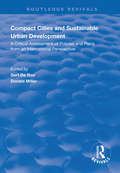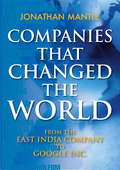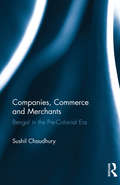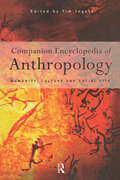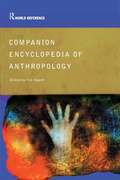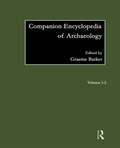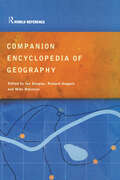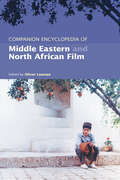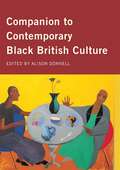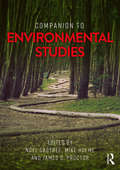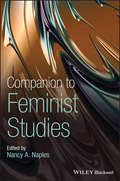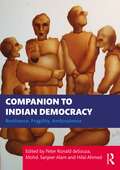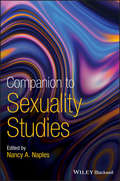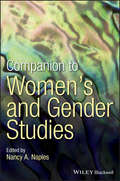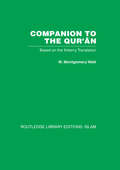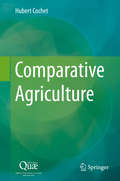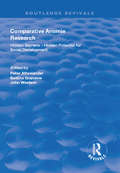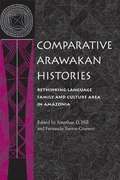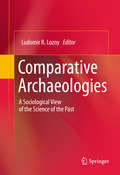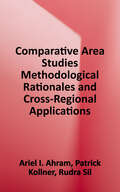- Table View
- List View
Como Ser Uma Feminista: Um Guia Para Mulheres Lutarem Por Seus Direitos e Igualdade
by Lauren AlexaVocê já foi vítima de violência, ódio, assédio ou sofrimento por causa do seu gênero? Ser feminista ou praticar ideais feministas significa lutar pelo que importa. Coisas como salários iguais, ser tratada com respeito, licença maternidade, direitos de reprodução, violência doméstica, entre outros. Se quiser aprender mais sobre lutar por seus direitos e ajudar a lutar pelos direitos das mulheres em todo lugar, então este guia é para você. - Aprenda a ser feminista. - Aprenda a lutar por seus direitos. - Lute por igualdade e salários iguais. - E muito mais! Aprenda como estar no lado certo da história ajudando a humanidade onde ela mais precisa de você!
Como Ser uma Patricinha Básica: Guia Básico para Brunches, Capuccinos, Rosa, Moda, Filmes e Estilo de Vida da Patricinha Básica
by Hiddenstuff EntertainmentVocê é uma patricinha básica? Você gosta de vinho, amigos, brunch, cidades, moda, compras e tudo do mundo consumista? Não se envergonhe, o estilo de vida da patricinha básica é um dos estilos de vida mais agradáveis e luxuosos que você pode viver. Por que não se mimar e viver bem, ter uma aparência melhor que todas os outras e, o mais importante, ser feliz e saudável? Se este é o estilo de vida que você está vivendo ou aspira a viver, então este guia é para você. Aprenda os detalhes de ser uma patricinha básica e como fazê-lo melhor do que qualquer outra pessoa. Se você quer ser mais saudável, curar doenças ou melhorar o foco e o bem-estar, este guia é para você. -> Vá até o topo da página e clique em adicionar ao carrinho para comprar instantaneamente Isenção de responsabilidade Este autor e/ou o(s) proprietário(s) dos direitos não fazem reivindicações, promessas ou garantias com relação à precisão, integridade ou adequação do conteúdo deste livro, e expressamente se isentam da responsabilidade por erros e omissões no conteúdo deste. Este produto é apenas para uso de referência. Por favor, consulte um profissional antes de agir baseado em qualquer um dos conteúdos encontrados aqui.
Compact Cities and Sustainable Urban Development: A Critical Assessment of Policies and Plans from an International Perspective
by Donald Miller Gert De RooThis title was first published in 2000. Encouraging, even requiring, higher density urban development is a major policy in the European Community and of Agenda 21, and a central principle of growth management programmes used by cities around the world. This work takes a critical look at a number of claims made by proponents of this initiative, seeking to answer whether indeed this strategy controls the spread of urban suburbs into open lands, is acceptable to residents, reduces trip lengths and encourages use of public transit, improves efficiency in providing urban infrastructure and services, and results in environmental improvements supporting higher quality of life in cities.
Companies That Changed the World: From the East India Company to Google Inc.
by Jonathan MantleCompanies that Changed the World tells the fascinating stories of 50 joint-stock companies - or companies based on that model - that have exerted a critical influence on the social and economic history of the past four hundred years. As well describing clearly and accessibly the companies' growth and influence over time, and profiling the pioneering entrepreneurs who built them, Jonathan Mantle's text is crammed with intriguing and unexpected information: from the role played by the humble pigeon in the history of news dissemination to how a pharmacist's five-cent patent medicine became the world's most powerful brand. Each of the 50 companies profiled has changed and reflected change in - the world of its time, in far-reaching and often unexpected ways. Together, their stories amount to nothing less than a concise history of commerce and capitalism.
Companies, Commerce and Merchants: Bengal in the Pre-Colonial Era
by Sushil ChaudhuryThis anthology vastly expands our understanding of the much-misconstructed history of early modern Bengal and seeks to redress the misconception that economic decline in Bengal set in even before the British conquest of the region. Based on original sources from European and Indian archives and libraries, the essays underline that Bengal had a prosperous economy in the mid-eighteenth century and was suffering from neither economic nor political crisis.
Companion Encyclopaedia of Anthropology: Humanity, Culture And Social Life
by Tim IngoldThis comprehensive survey of contemporary thought in biological, social and cultural anthropology sets the foundation for their future development and integration. The principal rationale behind the Encyclopedia is to overcome the division and fragmentation within the approaches of the humanities and natural sciences to anthropology. It emphasizes interconnections between perspectives and sub-disciplines, producing a complete perspective on what it means to be human. The work consists of three parts--Humanity, Culture, and Social Life--and 40 major contributions. Part One emphasizes human beings as members of a species, how that species differs from others, how it has evolved, and how human populations have adapted to and in turn transformed their environments. Part Two deals with the origin and structure of human culture, and on the role of culture in action, perception, and cognition. Part Three examines the various aspects of the relationships and processes that are carried on by persons and groups in the course of social life. Useful features such as cross-references within the text, full biographical references, suggestions for further reading and carefully illustrated line drawings make this an indispensable resource for all students of anthropology or sociology.
Companion Encyclopedia of Anthropology: Humanity, Culture and Social Life
by Tim Ingold* Provides a comprehensive survey of contemporary thinking in biological, social and cultural anthropology and establishes the interconnections between these three fields.* Useful cross-references within the text, with full biographical references and suggestions for further reading.* Carefully illustrated with line drawings and photographs. 'The Companion Encyclopedia of Anthropology is a welcome addition to the reference literature. Bringing together authoritative, incisive and scrupulously edited contributions from some three dozen authors. The book achieves an impressive breadth of coverage of specialist areas.' - Times Higher Educational Supplement'Recommended for all anthropology collections, especially those in academic libraries.' - Library Journal 'This is a marvellous book and I am very happy to recommend it.' - Reference Reviews
Companion Encyclopedia of Archaeology (Routledge Companion Encyclopaedias Ser.)
by Graeme BarkerThis comprehensive, fully illustrated Companion answers the need for an in-depth archaeology reference that provides authoritative coverage of this complex and interdisciplinary field. The work brings together the myriad strands and the great temporal and spatial breadth of the field into two thematically organized volumes.In twenty-six authoritative and clearly-written essays, this Companion explores the origins, aims, methods and problems of archaeology. Each essay is written by a scholar of international standing and illustrations complement the text.
Companion Encyclopedia of Geography: The Environment and Humankind
by Ian Douglas Mike Robinson Prof Ian Douglas Richard John HuggetThe Companion Encyclopedia of Geography provides an authoritative and provocative source of reference for all those concerned with the earth and its people. Examining both physical and human geography and charting human activities within their habitat up to the present day, this Companion also asks what lies in the future:* A differentiated world* A world transformed by the growth of a global economy* The global scale of habitat modification* A world of questions* Changing worlds, changing geographies* Geographical futures.The forty-five self contained chapters are bound into a unifying whole by the editors' general and part introductions; each chapter provides details of the most useful sources of further reading and research, and the volume is concluded with a comprehensive index. This is an invaluable resource not only for students, teachers and researchers in the academic domain but also professionals in interested commercial and public-sector organisations.
Companion Encyclopedia of Middle Eastern and North African Film
by Oliver LeamanThe Companion Encyclopedia of Middle Eastern and North African Film is a unique, one volume work which illuminates a fascinating variety of cinema which is little known outside its own area. The Encyclopedia is divided into nine chapters, each written by a leading scholar in the field. Each chapter covers the history and major issues of film within that area, as well as providing bibliographies of the leading films, directors and actors. The areas covered are: Central Asia, Egypt, Iran, Lebanon, Syria, Iraq, Kuwait, Libya, The Magreb, Palestine, Turkey. This Encyclopedia will be an invaluable reference tool for students and scholars of Film and Media Studies. It contains more than 60 black and white photographs of featured films, includes references and suggestions for further reading at the end of each chapter, and the volume concludes with comprehensive name, film and general indexes.
Companion to Contemporary Black British Culture
by Alison DonnellThe Companion to Contemporary Black British Culture is the first comprehensive reference book to provide multidisciplinary coverage of the field of black cultural production in Britain. The publication is of particular value because despite attracting growing academic interest in recent years, this field is still often subject to critical and institutional neglect. For the purpose of the Companion, the term 'black' is used to signify African, Caribbean and South Asian ethnicities, while at the same time addressing the debates concerning notions of black Britishness and cultural identity.This single volume Companion covers seven intersecting areas of black British cultural production since 1970: writing, music, visual and plastic arts, performance works, film and cinema, fashion and design, and intellectual life. With entries on distinguished practitioners, key intellectuals, seminal organizations and concepts, as well as popular cultural forms and local activities, the Companion is packed with information and suggestions for further reading, as well as offering a wide lens on the events and issues that have shaped the cultural interactions and productions of black Britain over the last thirty years. With a range of specialist advisors and contributors, this work promises to be an invaluable sourcebook for students, researchers and academics interested in exploring the diverse, complex and exciting field of black cultural forms in postcolonial Britain.
Companion to Environmental Studies
by Mike Hulme Noel Castree James D. ProctorCompanion to Environmental Studies presents a comprehensive and interdisciplinary overview of the key issues, debates, concepts, approaches and questions that together define environmental studies today. The intellectually wide-ranging volume covers approaches in environmental science all the way through to humanistic and post-natural perspectives on the biophysical world. Though many academic disciplines have incorporated studying the environment as part of their curriculum, only in recent years has it become central to the social sciences and humanities rather than mainly the geosciences. ‘The environment’ is now a keyword in everything from fisheries science to international relations to philosophical ethics to cultural studies. The Companion brings these subject areas, and their distinctive perspectives and contributions, together in one accessible volume. Over 150 short chapters written by leading international experts provide concise, authoritative and easy-to-use summaries of all the major and emerging topics dominating the field, while the seven part introductions situate and provide context for section entries. A gateway to deeper understanding is provided via further reading and links to online resources. Companion to Environmental Studies offers an essential one-stop reference to university students, academics, policy makers and others keenly interested in ‘the environmental question’, the answer to which will define the coming century.
Companion to Feminist Studies
by Nancy A. NaplesA comprehensive overview of feminist scholarship edited by an internationally recognized and leading figure in the field Companion to Feminist Studies provides a broad overview of the rich history and the multitude of approaches, theories, concepts, and debates central to this dynamic interdisciplinary field. Comprehensive yet accessible, this edited volume offers expert insights from contributors of diverse academic, national, and activist backgrounds—discussing contemporary research and themes while offering international, postcolonial, and intersectional perspectives on social, political, cultural, and economic institutions, social media, social justice movements, everyday discourse, and more. Organized around three different dimensions of Feminist Studies, the Companion begins by exploring ten theoretical frameworks, including feminist epistemologies examining Marxist and Socialist Feminism, the activism of radical feminists, the contributions of Black feminist thought, and interrelated approaches to the fluidity of gender and sexuality. The second section focuses on methodologies and analytical frameworks developed by feminist scholars, including empiricists, economists, ethnographers, cultural analysts, and historiographers. The volume concludes with detailed discussion of the many ways in which pedagogy, political ecology, social justice, globalization, and other areas within Feminist Studies are shaped by feminism in practice. A major contribution to scholarship on both the theoretical foundations and contemporary debates in the field, this volume: Provides an international and interdisciplinary range of the essays of high relevance to scholars, students, and practitioners alike Examines various historical and modern approaches to the analysis of gender and sexual differences Addresses timely issues such as the difference between radical and cultural feminism, the lack of women working as scientists in academia and other research positions, and how activism continues to reformulate feminist approaches Draws insight from the positionality of postcolonial, comparative and transnational feminists Explores how gender, class, and race intersect to shape women’s e
Companion to Indian Democracy: Resilience, Fragility, Ambivalence
by Peter Ronald DeSouzaThis book presents a comprehensive overview of the contemporary experiences of democracy in India. It explores the modes by which democracy as an idea, and as a practice, is interpreted, enforced, and lived in India’s current political climate. The book employs ‘case studies’ as a methodological vantage point to evolve an innovative conceptual framework for the study of democracy in India. The chapters unpack a diverse range of themes such as democracy and Dalits; agriculture, new sociality and communal violence in rural areas; changing nature of political communication in India; role of anti-nuclear movements in democracies; issues of subaltern citizen’s voice, impaired governance and the development paradigm; free speech and segregation in the public sphere; and, the surveillance state and Indian democracy. These thematic explorations are arranged in an engaging sequence to offer a multifaceted narrative of Indian democracy especially in relation to the recent debates on citizenship and constitutionalism. A key critical intervention on contemporary politics in South Asia, this book will be essential reading for scholars and researchers of political studies, political science, political sociology, comparative government and politics, sociology, social anthropology, public administration, public policy, and South Asia studies. It will also be of immense interest to policymakers, journalists, think tanks, bureaucrats, and organizations working in the area.
Companion to Sexuality Studies
by Nancy A. NaplesAn inclusive and accessible resource on the interdisciplinary study of gender and sexuality Companion to Sexuality Studies explores the significant theories, concepts, themes, events, and debates of the interdisciplinary study of sexuality in a broad range of cultural, social, and political contexts. Bringing together essays by an international team of experts from diverse academic backgrounds, this comprehensive volume provides original insights and fresh perspectives on the history and institutional regulatory processes that socially construct sex and sexuality and examines the movements for social justice that advance sexual citizenship and reproductive rights. Detailed yet accessible chapters explore the intersection of sexuality studies and fields such as science, health, psychology, economics, environmental studies, and social movements over different periods of time and in different social and national contexts. Divided into five parts, the Companion first discusses the theoretical and methodological diversity of sexuality studies.Subsequent chapters address the fields of health, science and psychology, religion, education and the economy. They also include attention to sexuality as constructed in popular culture, as well as global activism, sexual citizenship, policy, and law. An essential overview and an important addition to scholarship in the field, this book: Draws on international, postcolonial, intersectional, and interdisciplinary insights from scholars working on sexuality studies around the world Provides a comprehensive overview of the field of sexuality studies Offers a diverse range of topics, themes, and perspectives from leading authorities Focuses on the study of sexuality from the late nineteenth century to the present Includes an overview of the history and academic institutionalization of sexuality studies The Companion to Sexuality Studies is an indispensable resource for scholars, researchers, instructors, and students in gender, sexuality, and feminist studies, interdisciplinary programs in cultural studies, international studies, and human rights, as well as disciplines such as anthropology, psychology, history, education, human geography, political science, and sociology.
Companion to Urban Design
by Tridib Banerjee Anastasia Loukaitou-SiderisToday the practice of urban design has forged a distinctive identity with applications at many different scales – ranging from the block or street scale to the scale of metropolitan and regional landscapes. Urban design interfaces many aspects of contemporary public policy – multiculturalism, healthy cities, environmental justice, economic development, climate change, energy conservations, protection of natural environments, sustainable development, community liveability, and the like. The field now comprises a core body of knowledge that enfolds a right history of ideas, paradigms, principles, tools, research and applications, enriched by electric influences from the humanities, and social and natural sciences. Companion to Urban Design includes more than fifty original contributions from internationally recognized authorities in the field. These contributions address the following questions: What are the important ideas that have shaped the field and the current practice of urban design? What are the major methods and processes that have influenced the practice of urban design at various scales? What are the current innovations relevant to the pedagogy of urban design? What are the lingering debates, conflicts ad contradictions in the theory and practice of urban design? How could urban design respond to the contemporary challenges of climate change, sustainability, active living initiatives, globalization, and the like? What are the significant disciplinary influences on the theory, research and practice of urban design in recent times? There has never before been a more authoritative and comprehensive companion that includes core, foundational and pioneering ideas and concepts of urban design. This book serves as an invaluable guide for undergraduate and postgraduate students, future professionals, and practitioners interested in architecture, landscape architecture, and urban planning, but also in urban studies, urban affairs, geography, and related fields.
Companion to Women's and Gender Studies
by Nancy A. NaplesA comprehensive overview of the interdisciplinary field of Women's and Gender Studies, featuring original contributions from leading experts from around the world The Companion to Women's and Gender Studies is a comprehensive resource for students and scholars alike, exploring the central concepts, theories, themes, debates, and events in this dynamic field. Contributions from leading scholars and researchers cover a wide range of topics while providing diverse international, postcolonial, intersectional, and interdisciplinary insights. In-depth yet accessible chapters discuss the social construction and reproduction of gender and inequalities in various cultural, social-economic, and political contexts. Thematically-organized chapters explore the development of Women's and Gender Studies as an academic discipline, changes in the field, research directions, and significant scholarship in specific, interrelated disciplines such as science, health, psychology, and economics. Original essays offer fresh perspectives on the mechanisms by which gender intersects with other systems of power and privilege, the relation of androcentric approaches to science and gender bias in research, how feminist activists use media to challenge misrepresentations and inequalities, disparity between men and women in the labor market, how social movements continue to change Women's and Gender Studies, and more. Filling a significant gap in contemporary literature in the field, this volume: Features a broad interdisciplinary and international range of essays Engages with both individual and collective approaches to agency and resistance Addresses topics of intense current interest and debate such as transgender movements, gender-based violence, and gender discrimination policy Includes an overview of shifts in naming, theoretical approaches, and central topics in contemporary Women's and Gender Studies Companion to Women's and Gender Studies is an ideal text for instructors teaching courses in gender, sexuality, and feminist studies, or related disciplines such as psychology, history, education, political science, sociology, and cultural studies, as well as practitioners and policy makers working on issues related to gender and sexuality.
Companion to the Qur'an: Based on the Arberry Translation
by W.M. WattOriginally published in 1967, this Companion is designed to help readers of the Qur’an by giving them necessary background information. An account is given of ideas peculiar to the Qur’an, and the main variant interpretations are noted. A full index of Qur’anic proper names and an index of words commented on has been provided. Based on A J Arberry’s translation, this Companion can be used with other translations, or indeed with the original text, since the verses are numbered.
Company Towns
by Neil WhiteCompany towns are often portrayed as powerless communities, fundamentally dependent on the outside influence of global capital. Neil White challenges this interpretation by exploring how these communities were altered at the local level through human agency, missteps, and chance. Far from being homogeneous, these company towns are shown to be unique communities with equally unique histories.Company Towns provides a multi-layered, international comparison between the development of two settlements--the mining community of Mount Isa, Queensland, Australia, and the mill town of Corner Brook, Newfoundland, Canada. White pinpoints crucial differences between the towns' experiences by contrasting each region's histories from various perspectives--business, urban, labour, civic, and socio-cultural. Company Towns also makes use of a sizable collection of previously neglected oral history sources and town records, providing an illuminating portrait of divergence that defies efforts to impose structure on the company town phenomenon.
Comparative Agriculture
by Hubert CochetIn the first section dedicated to theoretical thoughts on comparative agriculture, Hubert Cochet introduces the notion of "agricultural development", the very subject of comparative agriculture, with a restored endogenous dimension. He then describes how this approach was slowly consolidated, around the concept of agrarian system in particular. The comparison of agricultural transformations in time and space highlights the importance of the comparatist approach to production processes, their trajectories and differentiation on a worldwide scale. The second section which focuses on the methods and expertise of comparative agriculture, tackles the issues of landscape analysis, field surveys and the historical approach underlying comparative agriculture. It sums up the economic tools mobilised as well as the evaluation perspectives opened up by comparative agriculture.
Comparative Anomie Research: Hidden Barriers - Hidden Potential for Social Development
by PETER ATTESLANDER, BETTINA GRANSOW AND JOHN WESTERNThis title was first published in 2000: This text presents the results of a three-year study in social research, which aimed to measure and explain anomie in different parts of the world with different cultures and different socio-political and economic conditions. Both quantitative and qualitative methods were applied, and the book not only represents the projects in juxtaposition, but also attempts to show how they relate to each other. The project elaborated instruments for practical use of both public and private agents in development co-operation in order to assess the stability or instability of a given society and to orient development policies accordingly. The book aims to provide the basis for an early detection system for anomie. The main interest is intercultural setting, the detection of hidden anomic potential and the close linkages between scientific research and its applicability for development policy and practice in applied anomie research.
Comparative Arawakan Histories: Rethinking Language Family and Culture Area in Amazonia
by Jonathan D. Hill Fernando Santos-GraneroBefore they were largely decimated and dispersed by the effects of European colonization, Arawak-speaking peoples were the most widespread language family in Latin America and the Caribbean, and they were the first people Columbus encountered in the Americas. Comparative Arawakan Histories, in paperback for the first time, examines social structures, political hierarchies, rituals, religious movements, gender relations, and linguistic variations through historical perspectives to document sociocultural diversity across the diffused Arawakan diaspora.
Comparative Archaeologies: A Sociological View of the Science of the Past
by Ludomir R. LoznyArchaeology, as with all of the social sciences, has always been characterized by competing theoretical propositions based on diverse bodies of locally acquired data. In order to fulfill local, regional expectations, different goals have been assigned to the practitioners of Archaeology in different regions. These goals might be entrenched in local politics, or social expectations behind cultural heritage research. This comprehensive book explores regional archaeologies from a sociological perspective--to identify and explain regional differences in archaeological practice, as well as their existing similarities. This work covers not only the currently-dominant Anglo-American archaeological paradigm, but also Latin America, Western and Eastern Europe, Asia, and Africa, all of which have developed their own unique archaeological traditions. The contributions in this work cover these "alternative archaeologies," in the context of their own geographical, political, and socio-economic settings, as well as the context of the currently accepted mainstream approaches.
Comparative Area Studies: Methodological Rationales and Cross-Regional Applications
by Ariel I. Ahram Rudra Sil Patrick KöllnerIn the post-World War II era, the emergence of 'area studies' marked a signal development in the social sciences. As the social sciences evolved methodologically, however, many dismissed area studies as favoring narrow description over general theory. Still, area studies continue to play a key, if unacknowledged, role in bringing new data, new theories, and valuable policy-relevant insights to social sciences. In Comparative Area Studies, three leading figures in the field have gathered an international group of scholars in a volume that promises to be a landmark in a resurgent field. The book upholds two basic convictions: that intensive regional research remains indispensable to the social sciences and that this research needs to employ comparative referents from other regions to demonstrate its broader relevance. Comparative Area Studies (CAS) combines the context-specific insights from traditional area studies and the logic of cross- and inter-regional empirical research. This first book devoted to CAS explores methodological rationales and illustrative applications showing how area-based expertise can link into cutting-edge comparative analytical frameworks.
Comparative Bone Identification: Human Subadult and Nonhuman - A Field Guide
by Diane L. FranceBuilding on the success, and maintaining the format, of Comparative Bone Identification: Human Subadult and Non-Human (ISBN: 9780367777883), Comparative Bone Identification: Human Subadult and Non-Human – A Field Guide presents new images of human bones representing many states of maturation from neonate to 20 years old in comparison to a variety of animal species’ bones. Highly illustrated, the book takes a visual approach and provides full annotations pointing out salient features of the most commonly discovered bones. This includes smaller bones of fetuses and subadult humans in comparison to bones of birds, reptiles, marine mammals, fish, and a frog that human bones may most be confused with. Full-color photos provide clear examples for use by law enforcement, medicolegal death investigators, forensic anthropologists, students, and readers who wish to distinguish between human bones and those of a variety of animal species. The book is not intended to be an exhaustive guide to human and nonhuman skeletons. It offers myriad photos and illustrations to help aid in identification and avoid some of the more commonly confused animal bones for human. The book begins with an introduction section on general osteology and explains the major anatomical differences between humans and other animals. The second section compares human and nonhuman bones, categorized by type of bone, and includes most of the major bones in humans and nonhumans. The third section presents of radiographs illustrated documented age in humans. Conveniently designed for field use, Comparative Bone Identification: Human Subadult to Nonhuman – A Field Guide offers users a practical comparative guide that presents the differences among species for nearly all bones in the body. The book serves as a valuable resource of easy-to-access information to investigators and forensic anthropologists for use in the laboratory or in the field.


